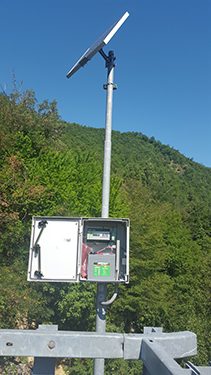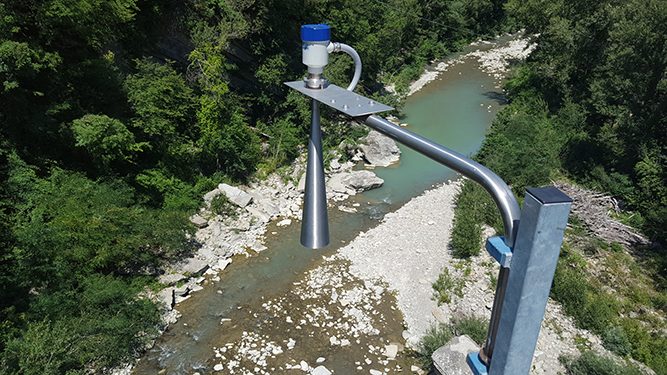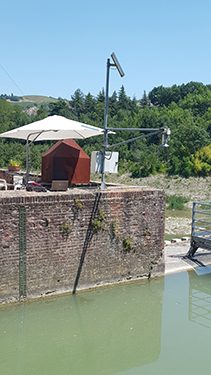Hydrologic monitoring system for municipal civil defence purposes
(System for 24/7 monitoring of the hydrometric level to protect the territory and the citizens)
- 2016
- Imola

Challenge
Execution of a stand-alone hydrometric monitoring system able to automatically handle hydrologic alert situations to protect the territory and the citizens.Why ETG
The wealth of experience that ETG has acquired in the weather instrumentation sector and in real-time monitoring data acquisition, archiving, processing and circulation makes it a valuable collaborator.Introduction
The monitoring system in question consists of 2 fixed stations that continuously calculate the hydrometric level, stirruped on two different bridges crossing the Santerno river. The two stations, positioned on the same river but several kilometres from each other, accurately measure the hydrometric level and, at the same time, the time for the flood wave to propagate. This latter parameter is calculated by verifying the time elapsing between the two hydrometric level peaks for the two stations, one installed further upstream and the other further downstream.The solution
The system, consisting of the elements described above and powered by solar panels, is able to monitor the hydrometric level of the Santerno river and to send it to the Municipal Civil Defence system managed in hosting at ETG by GPRS vector. If the hydrometric level passes the thresholds agreed upon with the civil defence service, the system automatically sends a transmitted alarm message by email and SMS to the municipal personnel on call, to the operators and to the mayors of the neighbouring municipalities affected. The system also uses hydrometric radar sensors that compared to their ultrasonic cousins are much more accurate because they are immune to the atmospheric pressure and ambient temperature variations to which the latter are sensitive. Thanks to their principle of measurement, the radar sensors are indeed completely immune to the changes in environmental conditions, thus guaranteeing very high standards of measurement and accuracy in any operating condition.The benefits
Having a hydrometric monitoring system like the one in question lets the municipality have a particularly useful measurement and alert tool in cases of hydrogeological alert. Systems like the one ETG offered to the City of Imola reduce the operators’ intervention time in the field and provide the precise image of the state of the monitored waterways at all times. Where the goal is to protect the territory and the citizens, time is a crucial issue and managing an alert situation quickly can truly make the difference. Furthermore, having the system managed by ETG through its hosting services allows the customer to free itself from having physical machines where its applications reside at its facility. This type of solution guarantees 24/7 operation of the control centre, freeing the customer from having to perform costly maintenance on it.Closing section
Every new monitoring system engineered by ETG entails peculiarities that can be solved only by those - like our company - that have been working in the sector for years. In the case of the system made for the City of Imola, it led to a conflict with an installation situation for one of the two stations that is particularly complex in terms of connectivity and operating range of the hydrometric sensor since it was necessary to install a version of the hydrometric sensor made by ETG, which goes by the trade name of RLS, with a measurement range that would go well beyond 30 metres.Materials to download
Case History


